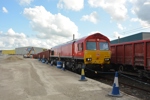The first passenger trains will run on the £294 million Borders rail link on September 6 2015, almost 50 years after the last passenger journeys ended on the route.
Some 30 miles of the original Waverley route between Edinburgh, Galashiels and Tweedbank is being reinstated. There will be seven new stations - four in Midlothian and three in the Borders.
The route will be operated by the new ScotRail franchisee that takes control in April 2015, and will offer end-to-end journey times of between 55 minutes and one hour.
Announcing the opening date, Scottish First Minister Alex Salmond also revealed that a feasibility study would look at ways in which the railway could be used to boost tourism in the Borders region, with a “steam train experience” potentially beginning in September 2015, and the permanent exhibition of the Great Tapestry of Scotland at Tweedbank station.
“We can expect the Scottish economy to benefit by tens of millions of pounds from the regular train line,” said Salmond in a meeting with members of the Scottish Borders Council and other local representatives on August 20.
“From September 2015 - for the first time in almost half a century - there will be passenger train services running on this track.
“For commuters and tourists alike, the re-opened line will provide opportunities to enjoy the many fantastic attractions and experiences on offer in the Borders.”
However, according to the Campaign for Borders Rail, the only way tourist charter trains can be accommodated on the single-track railway will be to reduce the half-hourly daytime frequency of ScotRail services. The CBR has been consistently pressing for improvements to the project plans.
Much of the infrastructure is single-track with ‘dynamic’ passing loops, designed to provide capacity for half-hourly ScotRail trains, with no paths provided for other services. The exception to this is during the evenings and on Sundays, when the frequency will be reduced to hourly.
Borders Rail campaigner and railway consultant David Spaven said that reducing the ScotRail train frequency to hourly in the middle of the day on Saturdays, to accommodate tourist charter trains, was “not ideal”, but that hourly ScotRail trains could potentially be lengthened to cater for the extra demand.
“It’s very unfortunate the railway promoters and the political establishment ignored rail campaigners when they were pointing out these infrastructure constraints on tourist potential more than ten years ago,” he said. “They were warned, but chose to ignore well-informed advice.”
Under the project’s current plans, the platform at Galashiels station will be extended to accommodate longer tourist trains, such as steam-hauled charters.
It has also emerged that a ScotRail unit will be covered in special livery advertising the tourist potential of the Borders - probably one of the Class 158s expected to be dedicated to the route.
Meanwhile, the construction of the railway is fast approaching its next phase, with the focus of the work shifting from heavy civil engineering towards track laying and station construction.
Considerable progress has been made on the station platforms at Shawfair and Eskbank; platform construction is under way at Stow; work has started on the stations at Newtongrange and Gorebridge; and at Galashiels, work has begun to construct the new station opposite the town’s new transport interchange.
Elsewhere, work continues to install bridges on the southern section of the route.
The upgrade of Victorian cuttings has also been completed, with new retaining walls installed and embankments strengthened with stone.
During August, sleepers were positioned beside the trackbed, ballast was stockpiled along much of the route, and signal and crossing units arrived.
















Login to comment
Comments
No comments have been made yet.